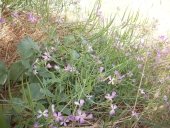Yes but they are still related ....... there are many plants that come from this same kingdom, I think even artichokes are in the family somewhere
this is from wikipedia
Common chicory
Botanical illustration of chicory
Scientific classification e
Kingdom: Plantae
Clade: Angiosperms
Clade: Eudicots
Clade: Asterids
Order: Asterales
Family: Asteraceae
Genus: Cichorium
Species: C. intybus
Binomial name
Cichorium intybus
L.
Synonyms[2][3]
Synonymy[show]
Common chicory, Cichorium intybus,[4] is a somewhat woody,
perennial herbaceous plant of the dandelion family Asteraceae, usually with bright blue flowers, rarely white or pink. Many varieties are cultivated for salad leaves, chicons (blanched buds), or roots (var. sativum), which are baked, ground, and used as a coffee substitute and food additive. In the 21st century, inulin, an extract from chicory
root, has been used in food manufacturing as a sweetener and source of dietary fiber.[5]
Chicory is grown as a forage crop for livestock.[6] It lives as a wild plant on roadsides in its
native Europe, and is now common in North America, China, and Australia, where it has become widely naturalized.[7][8][9] "Chicory" is also the common name in the United States for curly endive (Cichorium endivia); these two closely related species are often confused.[10]





 2
2












 4
4
















![Filename: mustardy-green-leaf-bottom.jpg
Description: [Thumbnail for mustardy-green-leaf-bottom.jpg]](/t/88869/a/62609/mustardy-green-leaf-bottom.jpg)
![Filename: mustardy-green-leaf-face.jpg
Description: [Thumbnail for mustardy-green-leaf-face.jpg]](/t/88869/a/62610/mustardy-green-leaf-face.jpg)
![Filename: mustardy-green-in-flower1.jpg
Description: [Thumbnail for mustardy-green-in-flower1.jpg]](/t/88869/a/62611/mustardy-green-in-flower1.jpg)
 1
1

































 2
2









